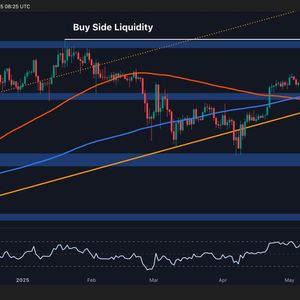BitcoinWorld Ethereum Withdrawals: Massive $516M Pulled from Exchanges – What it Means The world of cryptocurrency is constantly moving, and tracking where assets are held can offer valuable clues about market sentiment and trader intentions. This week, a significant movement has caught the eye of analysts: a massive $516 million worth of Ethereum (ETH) has been withdrawn from centralized crypto exchanges. This notable outflow, reported by on-chain analytics firm Sentora (formerly IntoTheBlock), suggests a shift in strategy among crypto traders . Instead of keeping their assets readily available for trading on exchanges, they appear to be moving them into private wallets. But what exactly does this mean for the Ethereum market and the broader crypto landscape? Understanding Ethereum Withdrawals Through On-Chain Data The figure of $516 million in Ethereum withdrawals comes directly from analysis of public blockchain data, often referred to as on-chain data . Firms like Sentora specialize in interpreting these transparent records to provide insights into market activity that aren’t immediately obvious from price charts alone. When users withdraw assets like ETH from exchanges , it’s recorded on the Ethereum blockchain. By aggregating these transactions across major exchange wallets, analysts can track net flows – whether more ETH is entering or leaving exchanges. A large net outflow, as seen this week, indicates that a substantial amount of ETH is being moved off trading platforms. This metric is considered important for crypto market analysis because exchange balances can be a proxy for potential selling pressure. Assets held on exchanges are typically there for trading or potential sale. Assets moved off exchanges are more likely intended for long-term holding, staking, or use in decentralized applications (DeFi). Why Are Crypto Traders Moving ETH Off Exchanges? Several factors could be driving this trend of Ethereum withdrawals . Understanding these motivations helps paint a clearer picture of current market dynamics: Enhanced Security: Self-Custody is Key Many experienced crypto traders and investors prefer to hold their assets in wallets where they control the private keys. This is known as self-custody. Moving ETH from exchanges to hardware wallets or software wallets significantly reduces counterparty risk – the risk that the exchange itself could be hacked, become insolvent, or face regulatory issues that freeze funds. The mantra ‘not your keys, not your crypto’ resonates strongly after past market events. Long-Term Holding (HODLing) Strategy Withdrawals can signal an intent to hold ETH for the long term, rather than trade it actively. When traders anticipate potential future price appreciation, they often move assets off exchanges to resist the temptation of short-term trading and signal their conviction in the asset’s value. This aligns with a ‘HODLing’ strategy, a common approach among believers in Ethereum’s future. Staking Ethereum Since Ethereum’s transition to Proof-of-Stake (the Merge), many ETH holders choose to stake their ETH to earn rewards and help secure the network. Staking often involves moving ETH away from centralized exchanges to personal wallets or staking platforms. This is a significant driver of Ethereum withdrawals , as users commit their ETH for potentially extended periods. Reduced Selling Pressure Perhaps the most immediate market implication is the potential reduction in selling pressure. With $516 million less ETH readily available on trading platforms, there is simply less supply that can be quickly sold onto the market. This dynamic can be a bullish signal, especially if demand remains constant or increases. Engagement with Decentralized Finance (DeFi) and NFTs Accessing the full spectrum of the Ethereum ecosystem, including DeFi protocols (lending, borrowing, yield farming) and NFT marketplaces, typically requires using a non-custodial wallet. Traders moving ETH from exchanges might be preparing to participate more actively in these decentralized sectors. What Does This On-Chain Data Signal for the Ethereum Market? The substantial outflow of ETH from exchanges is generally interpreted by analysts performing crypto market analysis as a potentially positive or bullish signal. Here’s why: Potential Supply Shock: Less supply available on exchanges combined with consistent or growing demand could lead to upward price pressure. If a large amount of ETH is locked away in staking or private wallets, the circulating supply available for trading decreases. Accumulation Phase: Large withdrawals often suggest that significant holders or institutions are accumulating ETH at current price levels, viewing it as an opportune time to add to their positions with a long-term outlook. Shift in Sentiment: It reflects a potential shift from a trading-focused mindset to a holding or utility-focused mindset among a large group of crypto traders . This confidence can be contagious and influence broader market sentiment. While on-chain data like exchange flows provides valuable insights, it’s crucial to remember it’s just one piece of the puzzle in comprehensive crypto market analysis . Macroeconomic factors, regulatory news, technological developments within the Ethereum network (like upcoming upgrades), and overall market sentiment also play significant roles. Comparing Ethereum Withdrawals to Broader Crypto Trends Is this trend unique to Ethereum? While the $516 million figure for Ethereum withdrawals this week is substantial for ETH, similar patterns of assets moving off exchanges are often observed across the broader crypto market during periods where investors anticipate positive price action or seek greater security. Bitcoin, for instance, also sees significant movements off exchanges when accumulation phases are believed to be underway. However, Ethereum’s specific use cases, particularly its dominance in DeFi and NFTs and the increasing popularity of ETH staking, provide additional, unique reasons for users to move their ETH from exchanges compared to assets primarily used as a store of value. Actionable Insights for Crypto Traders For crypto traders looking at this data, what are the takeaways? Stay Informed: Keep an eye on on-chain data metrics like exchange flows, not just for ETH but for other assets you trade. Platforms like Sentora (IntoTheBlock) or Glassnode offer these insights. Evaluate Your Strategy: Consider your own risk tolerance and investment horizon. If you are a long-term holder, ensuring your assets are secure in a private wallet should be a priority. If you are an active trader, understanding these larger movements can inform your short-term decisions. Prioritize Security: Regardless of where you store your crypto, security is paramount. For assets held off exchanges, this means properly managing private keys, using hardware wallets for significant amounts, and being wary of phishing attempts. Diversify Information Sources: Don’t rely on a single metric. Combine on-chain data with technical analysis, fundamental analysis of the Ethereum network, and overall crypto market analysis to form a well-rounded view. Conclusion: What the Massive ETH Outflow Tells Us The withdrawal of a massive $516 million in Ethereum (ETH) from centralized exchanges this week is a significant data point from the world of on-chain data . It strongly suggests that a large number of crypto traders are opting for self-custody and potentially long-term holding strategies over keeping their ETH from exchanges readily available for sale. This trend has important implications for crypto market analysis , potentially indicating reduced selling pressure and a bullish sentiment among those accumulating ETH. While not a guaranteed predictor of future price movements, large outflows like this are a key metric that serious traders and investors watch closely as they navigate the dynamic Ethereum market . To learn more about the latest Ethereum and crypto market trends, explore our articles on key developments shaping Ethereum price action and institutional adoption . This post Ethereum Withdrawals: Massive $516M Pulled from Exchanges – What it Means first appeared on BitcoinWorld and is written by Editorial Team


















